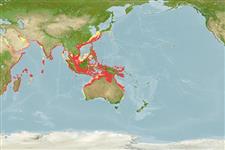>
Siluriformes (Catfishes) >
Ariidae (Sea catfishes) > Ariinae
Etymology: Netuma: A Tamil word that means "dance".
More on author: Rüppell.
Environment: milieu / climate zone / depth range / distribution range
Οικολογία
Θαλασσινό(ά); Γλυκού νερού; Υφάλμυρο βενθικό(ς); αμφίδρομο (Ref. 51243); εύρος βάθους 10 - 195 m (Ref. 12260). Subtropical; 34°N - 34°S, 32°E - 154°E
Indo-West Pacific: known with certainty from the Red Sea and the northwestern Indian Ocean. Also reported from Australia, Polynesia and Japan and rarely in the Mekong delta (Ref. 12693).
Length at first maturity / Μέγεθος / Βάρος / Age
Maturity: Lm 36.3, range 33 - 45 cm
Max length : 185 cm TL αρσενικό/απροσδιόριστο; (Ref. 30573); common length : 70.0 cm TL αρσενικό/απροσδιόριστο; (Ref. 9987); μεγ. δημοσιευμένο βάρος: 1.0 kg (Ref. 4883)
A marine species often found in estuaries, but rarely enters freshwater. Typically euryhaline (Ref. 3876). Reported to occasionally ascend into fresh water (Ref. 12693). Recorded at temperatures ranging from 26-29°C. Feeds mainly on crabs, prawns, mantis shrimps (Squilla species) but also on fishes and mollusks. An important food fish. Marketed mostly fresh; often dried.
Incubates eggs in the mouth. The fry continue to take refuge in the mouths of the male fish for the first 2 months and once they leave, the males start to eat avidly and may consume their ouwn young.
Rainboth, W.J., 1996. Fishes of the Cambodian Mekong. FAO species identification field guide for fishery purposes. FAO, Rome, 265 p. (Ref. 12693)
IUCN Red List Status (Ref. 130435)
Threat to humans
Traumatogenic (Ref. 58010)
Human uses
Warning: mysqli::__construct(): (HY000/1040): Too many connections in /var/www/html/includes/func_getlabel.php on line 46
Can't connect to MySQL database (fbapp). Errorcode: Too many connections
